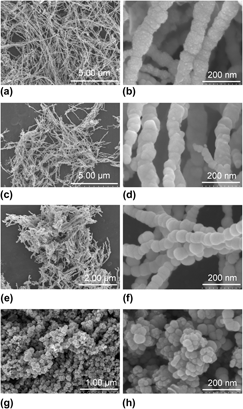Crossref Citations
This article has been cited by the following publications. This list is generated based on data provided by
Crossref.
Zhang, Shuyuan
and
Cao, Quanxi
2012.
Electromagnetic and microwave absorption performance of some transition metal doped La0.7Sr0.3Mn1−xTMxO3±δ (TM=Fe, Co or Ni).
Materials Science and Engineering: B,
Vol. 177,
Issue. 9,
p.
678.
Tong, Guoxiu
Hu, Qian
Wu, Wenhua
Li, Wei
Qian, Haisheng
and
Liang, Yan
2012.
Submicrometer-sized NiO octahedra: facile one-pot solid synthesis, formation mechanism, and chemical conversion into Ni octahedra with excellent microwave-absorbing properties.
Journal of Materials Chemistry,
Vol. 22,
Issue. 34,
p.
17494.
Tong, Guoxiu
Guan, Jianguo
and
Zhang, Qingjie
2013.
In Situ Generated Gas Bubble‐Directed Self‐Assembly: Synthesis, and Peculiar Magnetic and Electrochemical Properties of Vertically Aligned Arrays of High‐Density Co3O4 Nanotubes.
Advanced Functional Materials,
Vol. 23,
Issue. 19,
p.
2406.
Hu, Qian
Tong, Guoxiu
Wu, Wenhua
Liu, Fangting
Qian, Haisheng
and
Hong, Danyan
2013.
Selective preparation and enhanced microwave electromagnetic characteristics of polymorphous ZnO architectures made from a facile one-step ethanediamine-assisted hydrothermal approach.
CrystEngComm,
Vol. 15,
Issue. 7,
p.
1314.
Tong, Guoxiu
Du, Fangfang
Xiang, Lingjing
Liu, Fangting
Mao, Lulu
and
Guan, Jianguo
2014.
Generalized green synthesis and formation mechanism of sponge-like ferrite micro-polyhedra with tunable structure and composition.
Nanoscale,
Vol. 6,
Issue. 2,
p.
778.
Khan, Kishwar
and
Rehman, Sarish
2014.
Microwave absorbance properties of zirconium–manganese substituted cobalt nanoferrite as electromagnetic (EM) wave absorbers.
Materials Research Bulletin,
Vol. 50,
Issue. ,
p.
454.
Tong, Guoxiu
Liu, Yun
Liu, Fangting
and
Guan, Jianguo
2015.
Easy gas-flow-induced CVD synthesis and tunable electromagnetic characteristics of centipede-shaped iron/cementite/multiwalled carbon nanotube (Fe/Fe3C/MWCNT) heterostructures.
Surface and Coatings Technology,
Vol. 283,
Issue. ,
p.
286.
Jazirehpour, M.
and
Seyyed Ebrahimi, S.A.
2015.
Effect of aspect ratio on dielectric, magnetic, percolative and microwave absorption properties of magnetite nanoparticles.
Journal of Alloys and Compounds,
Vol. 638,
Issue. ,
p.
188.
Li, Yana
Wu, Tong
Jiang, Kedan
Tong, Guoxiu
Jin, Keying
Qian, Naxin
Zhao, Leihong
and
Lv, Tianxi
2016.
Mn2+ induced structure evolution and dual-frequency microwave absorption of MnxFe3−xO4 hollow/porous spherical chains made by a one-pot solvothermal approach.
Journal of Materials Chemistry C,
Vol. 4,
Issue. 29,
p.
7119.
Wu, Tong
Zhao, Yanting
Li, Yana
Wu, Wenhua
and
Tong, Guoxiu
2017.
Controllable Synthesis of CuxFe3−xO4@Cu Core–Shell Hollow Spherical Chains for Broadband, Lightweight Microwave Absorption.
ChemCatChem,
Vol. 9,
Issue. 18,
p.
3486.
Jin, Chen
He, Zidong
Zhao, Yanting
Pan, Yefei
Wu, Wenhua
Wang, Xiaojuan
and
Tong, Guoxiu
2018.
Controllable synthesis, formation mechanism, and enhanced microwave absorption of dendritic AgFe alloy/Fe3O4 nanocomposites.
CrystEngComm,
Vol. 20,
Issue. 14,
p.
1997.
Azizi, P.
Masoudpanah, S.M.
and
Alamolhoda, S.
2018.
Magnetic and microwave absorption properties of SrZnCoFe16O27 powders synthesized by solution combustion method.
Journal of Alloys and Compounds,
Vol. 739,
Issue. ,
p.
211.
Golchinvafa, S.
Masoudpanah, S.M.
and
Jazirehpour, M.
2019.
Magnetic and microwave absorption properties of FeCo/CoFe2O4 composite powders.
Journal of Alloys and Compounds,
Vol. 809,
Issue. ,
p.
151746.
Sun, Jia Cheng
He, Zidong
Dong, Wenjing
Wu, Wenhua
and
Tong, Guoxiu
2019.
Broadband and strong microwave absorption of Fe/Fe3C/C core–shell spherical chains enhanced by dual dielectric relaxation and dual magnetic resonances.
Journal of Alloys and Compounds,
Vol. 782,
Issue. ,
p.
193.
Yang, Ping-an
Ruan, Haibo
Sun, Yang
Li, Rui
Lu, Yi
and
Xiang, Chenye
2020.
Excellent microwave absorption performances of high length-diameter ratio iron nanowires with low filling ratio.
Nanotechnology,
Vol. 31,
Issue. 39,
p.
395708.
Li, Rui
Li, Xinyan
Yang, Ping-An
and
Ruan, Haibo
2020.
High-aspect-ratio iron nanowires: magnetic field-assisted in situ reduction synthesis and extensive parametric study.
Nanotechnology,
Vol. 31,
Issue. 14,
p.
145601.
Lu, Yao
Shao, Wen
Wu, Liwen
Liu, Lin
Tong, Guoxiu
and
Wu, Wenhua
2020.
Controllable preparation and broadband high-frequency absorption capabilities of Co fibers and Co/Cu bimetallic core-shell fibers.
Journal of Alloys and Compounds,
Vol. 847,
Issue. ,
p.
156509.
Liu, Qi
Dai, Jingxiong
Hu, Fei
Zhang, Zhiquan
Xiong, Kun
and
Xu, Guangliang
2021.
Core-shell structured Fe/ZnO composite with superior electromagnetic wave absorption performance.
Ceramics International,
Vol. 47,
Issue. 10,
p.
14506.
Zhang, Kaikai
Luo, Xixi
and
Xie, Hui
2022.
Tuning the Al content for flake Fe3Al powder to achieve wideband electromagnetic wave absorption.
Journal of Materials Science: Materials in Electronics,
Vol. 33,
Issue. 16,
p.
13290.
Yang, Ping-An
Huang, Yuxuan
Li, Rui
Huang, Xin
Ruan, Haibo
Shou, Mengjie
Li, Wanjun
Zhang, Yuxin
Li, Nan
and
Dong, Lichao
2022.
Optimization of Fe@Ag core–shell nanowires with improved impedance matching and microwave absorption properties.
Chemical Engineering Journal,
Vol. 430,
Issue. ,
p.
132878.





